Apple, Inc. opened its first two retail store locations 17 years ago – in May 2001 – in McLane, Virginia and Glendale, California. A year later, in 2002, my local store, Apple Bay Street in Emeryville, Calif. was opening its doors for the very first time. Let’s take a look back at the Apple Store experience from my vantage point and a little bit of its history as it approaches its 20th anniversary.
My First Apple Store Visit
Being the Apple fanatic that I was, I could not wait to line up to check out the new venture by Apple after seeing an ad for the grand opening for the Emeryville store in the newspaper. I woke up that Saturday morning and happily headed off to the new shopping center called Bay Street, which contained a mix of retail, restaurants, entertainment, and residential units all along a short street of the same name, all just off the heavily-traveled Main Street parallel to it. Only partially finished, they had decided to open some of the stores before the entire project had been completed.
It was a cloudy day and a bit drizzly and lucky me got a parking spot near the front of the store. If I remember correctly, the store opening was scheduled for 10:00 AM and I had gotten there about half-an-hour beforehand. There were a good number of people already lined up for the event. Not as big or rand as say an iPhone release but nevertheless significant enough. Remember that these were the early days of the Apple Store, and its grandeur and hype had not yet become mainstream.
I wondered what treasures would be in store once I walked in the doors. I knew there would be computers and software titles, but I envisioned them also selling things like clothing and accessories from keychains to pens bearing the Apple logo on them.
When the store finally opened its doors, they only let in a handful of people at a time, and when people left, they let more inside. So I patiently waited for my turn to go in.
Once I finally did, it was kind of exciting – but not what I had envisioned. There were of course computers on display, which were a Snow iMac G3, an iMac G4, and the Titanium PowerBook G4, just to name a few, some printers from the likes of Epson and HP, and software for the Mac. But nothing cheap that I could walk out with like a keychain or a pen or any clothing whatsoever, which I really had been hoping for.
I knew that this store was not for those without a credit card or two in their wallet, and I kind of wondered if the store would survive as much as I loved the idea. After all, what else would you expect to be paying at a store that sold high-end computers? Computers are big ticket items and not something you go in to buy weekly – or even yearly for that matter.
At least I was able to walk away from the experience with a free T-shirt commemorating the grand opening event – only a limited number were given out that morning. I exited the store not having purchased anything like I had planned to and was handed a plastic tube with a rolled up white shirt inside bearing a blue Apple logo with the store name “Bay Street” underneath. On the back was a barcode with the cutout of a white Apple logo with the words “Shop Different” underneath. Both sides of the shirt printed in the Apple Garamond font.
Apple Inside
Going back to the clothing and accessories, I thought that was what was going to set the Apple Store apart from say, CompUSA, which already had an Apple Shop area in it.
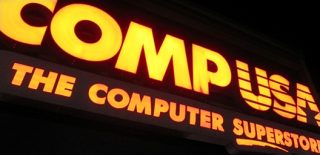
CompUSA store in Emeryville, California. (Photo: 2007, Joe Leo)
Why did I think that? I really don’t know. But one thing was for sure: The Apple Store was no different from CompUSA, and at least there were affordable things there that you could walk out with and a ton of other things you could buy at CompUSA, unlike at an Apple Store.
I wondered how the Apple Store and CompUSA would co-exist, since down the street five minutes away at the East Bay Bridge Shopping Center (also in Emeryville) was a CompUSA that carried all of Apple’s products. In that same shopping center too was a Best Buy store selling the same Apple merchandise, making the City of Emeryville (which is located east of San Francisco between the cities of Oakland and Berkeley) a mecca of sorts for Apple shoppers at one point, with all three stores within minutes of each other.
CompUSA was the first to sell Apple’s products at retail (it’s where we bought our first ever family computer, yes, a Mac) before there ever was an Apple Store having a four-year head start with its store-within-a-store model in place in 1997. Fry’s Electronics, a small retail chain spread across the U.S. with stores primarily in California and Texas, was another Apple authorized retailer who sold Apple products showcased in special sections of its stores. (Fry’s was contacted for this story to find out when they started selling Apple products in its stores but no response was received).
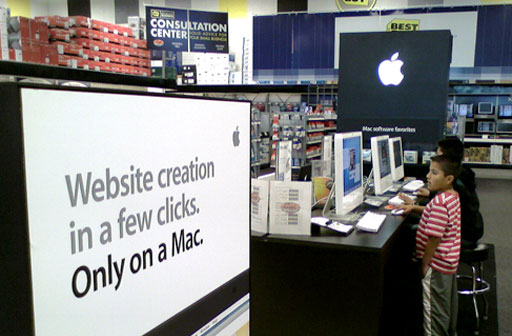
Apple inside Best Buy store in Emeryville, California. (Photo: 2007, Joe Leo)
In 2007, according to observations I reported, Best Buy — who had begun to officially sell Apple merchandise in its stores only a year earlier during the holiday season after a successful test pilot months before — expanded their Apple section inside the store concept nationwide which helped increase Apple’s retail presence in areas where there were no Apple Store locations. From the changes that took place with Apple products simply displayed without any attention to detail on store shelves to then getting a stylized product section showcased in its own area in the computer department, it appeared that Apple took control of their image and product placement and presentation in Best Buy stores after the initial partnership began.
In fact, because the Apple partnership with CompUSA was not going as Apple had hoped due to the Apple Shop being buried in the back of CompUSA stores where foot traffic was not as high, Apple was not receiving the product exposure it would have liked, and this prompted them to come up with the idea of the Apple Store.
CompUSA would shutter a number of underperforming stores in 2007 and eventually go out of business a year later in 2008. By that time, the Apple Store had already grown to 174 stores worldwide and had set itself apart as a strong contender in the retail sector.
The Retail Experience
Over the years, the Apple Store grew more popular, and even if you weren’t planning to buy any expensive merchandise, you went. The store just had that polarizing effect on you. It was a hangout spot. Or a place to socialize. But more so, it introduced and exposed non-fans to what the world of Apple was all about by giving them a chance to experience its products firsthand for themselves right there on the sales floor.
Like all of those various product launch days. For instance, the rumored black “next generation” iPod which I lined up for to check out for myself – but I did not walk out of the store with one after I learned that it was still white and the promotional poster teasing the new product gave the appearance that it was going to be black.
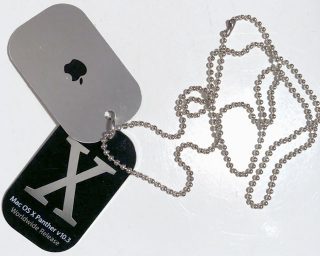
(Photo: 2018, Henry Leo)
Or Mac OS X release “parties” like 10.3 Panther, 10.4 Tiger, and 10.5 Leopard, where I lined up so I could test drive the new operating systems before purchasing them as well as to score the free giveaways in limited quantities – like a Panther-themed dog tag or a Leopard T-shirt, both of which sported the stylized “X” logo on the items.
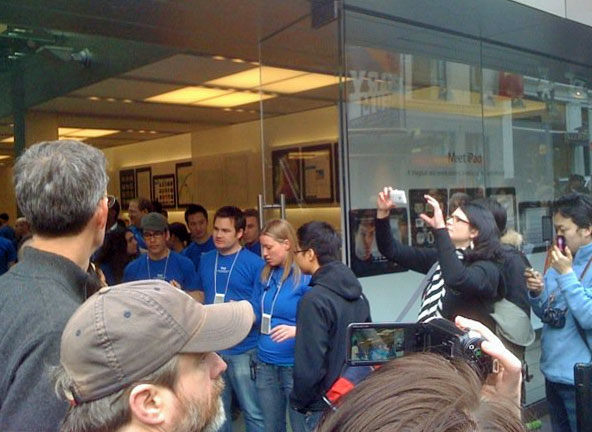
A long line of customers in front of the flagship Apple Store on Stockton Street in San Francisco anxiously await their turn to get their hands on the brand new iPad on the product’s release day event the morning of April 3, 2010 as store employees simultaneously work to greet guests and control the crowd eager to enter an already packed store. Note the person in line with their iPhone in hand high above the crowd recording the scene. (Photo: Joe Leo)
Then there were the huge events like the release of the original iPhone and iPad, where you had hordes of people lined up snaking around the block, two events which I would not attend as a customer but got to cover as a member of the media representing the PowerBook Central website (now merged with MacPrices, which I also write for as of May 2018).
And yes, there were those who were oblivious to the hype surrounding Apple product launch days walking down the sidewalk asking everyone what they were lining up for with puzzled looks on their faces.
By the Numbers
Apple had achieved what no other retail store could or has done. Statistics from a 2017 report show that Apple rakes in more than $5,546 in sales per square foot of their retail space in comparison to retail giant Walmart with $688.27 per square foot, which is more than double the $325 industry average according to an independent research report.
And the one reason Apple gave for it exiting the Macworld Expo as an exhibitor was that, as Apple Senior Vice President of Worldwide Marketing Phil Schiller said in his 2009 Keynote address, “3.4 million customers per week visit Apple Stores around the world. That’s 100 Macworlds each and every week!”
Unbeknownst to many, including myself for a period of time, Apple is not the host of the Macworld Expo and Conference (now on hiatus). They are an exhibitor, the main one, kind of like others who have showcased their products at the show in the past like Canon, Nikon, etc.
So because of the sheer numbers of customers visiting the Apple Store, the company can reach more than 100 million customers around the world directly which makes Apple less reliant on trade shows like Macworld according to a CNN story that highlighted the 2009 Macworld Expo and Keynote.
Apple All Around
Living in the San Francisco Bay Area, I have the luxury of having many Apple Store locations to shop at. Other locations I have visited are Apple Stoneridge in Pleasanton, Apple Valley Fair in Santa Clara, Apple Oakridge in San Jose, and the original flagship Apple Store at Stockton Street in San Francisco.
And those aren’t the only locations around the Bay Area. There are many more. A total of 18 stores which includes those I’ve visited.
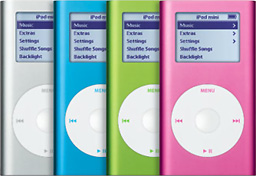
2G iPod mini
Prior to 2013, when I became blind, you could find me frequently visiting Apple Bay Street at least once a week. It was my “go to” Apple shop for making a purchase or getting service. It was where I would purchase my first ever iPod, a blue second generation (2G) 6 GB iPod mini. I also bought an Apple Store gift card there loaded with enough money for my sister to get a new white MacBook 13-inch as her college graduation gift so that she could replace her HP Pavilion PC notebook that she said gave her nothing but trouble through college. And the last Mac that I ever bought brand new was from there, a 2.53 GHz MacBook Pro 15-inch Late 2008, the first aluminum unibody model that was released.
Of course, the times that I needed a repair under warranty or help troubleshooting problems with a device would call for an appointment to their Genius Bar. Like a screen replacement for my 1.5 GHz PowerBook G4 12-inch and my iMac 20-inch Early 2009. Or help to solve technical difficulties like when my iPhone 3G would not sync to a backup after updating iOS.
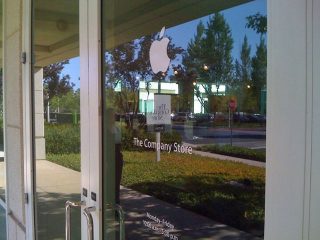
(Photo: 2010, Joe Leo)
There is one special Apple Store, the Company Store at their former original headquarters, Apple Campus at 1 Infinite Loop in Cupertino, Calif., that I finally had a chance to visit in 2010 during an educators conference being hosted on site. During my lunch break, I headed over to the Company Store – and finally, there was the Apple Store that sold the merchandise I was looking for!
This store sold shirts, jackets, mousepads, mugs, etc. all emblazoned with the Apple logo on them. Oddly enough the Company Store did not sell any hardware but they did, however, sell some software. I left the store having purchased three shirts – one for myself and two for friends – as a souvenir that said: “I visited the Mother Ship” printed in white with the current Apple Myriad font in white on the front of the black t-shirt and a white Apple logo on the back. They didn’t sell any pens, but as the saying goes, ask and you shall receive, and the cashier let me take for free a couple of the store pens that had an Apple logo on them.
I believe that Company Store still exists as it is listed in the store directory (as Infinite Loop), and according to that list, they opened one, a visitor’s center, at the company’s new headquarters at Apple Park. I have yet to visit Apple Park and wish I’d been able to see it before I became blind. I can only imagine what the place looks like in person since I did see some of the preliminary concept drawings before it was built.
Heck, I feel worse knowing Steve Jobs didn’t live to see his vision become a physical reality!
From Inception to Expansion
There was an interesting story I read recently on Fortune magazine’s website that told about how when Steve Jobs was envisioning the Apple Store they built actual mock-ups of the store concepts in a rented warehouse close to Apple Campus to test out how the whole thing would look and feel before actually proceeding with building the retail establishments. You can read the full interview with Jobs from 2007 here.
When the first stores began popping up, the critics were quick to the punch, saying that that the venture would fail. But Apple came and conquered, proving the critics wrong – including myself, since I initially had my doubts as well.
Today, almost two decades later, the Apple Store has grown to 270 locations nationwide and is a global phenomenon with more than 500 stores worldwide in 19 countries – a true dominating force in the retail sector with no signs of slowing down.
And the Apple Store establishments continue to grow and expand too.
The Bay Street store has relocated twice since it first opened in 2002. I don’t recall the exact year, but a number of years later when it had outgrown its original space, it moved two stores down (or up, depending on how you enter the shopping center) to a larger space from its first location, and just recently, in 2016, they moved yet again to another location with a much bigger space in the shopping center and now, according to the East Bay Times, is classified as a flagship Apple Store.
As far as growth, the two other Apple Store locations that I frequented have outgrown their original spaces as well. Either in the mall or standalone building and have moved to new and larger spaces. The Stoneridge store moved to a new place in the mall and the flagship store on Stockton Street in San Francisco moved to an entirely new location down at Union Square, an outdoor shopping plaza in the city’s downtown.
The most recent Apple Store that I visited was the Stoneridge store, and prior to that visit in March of this year, they were still at their old space in the mall which had the original layout with product tables in front and a Genius Bar in the back. Now they are in a different spot in the mall with increased space making it more inviting for people to gather, stay awhile, and socialize. Like a special area reserved for customers to meet for daily scheduled demos and presentations given by store employees or the removal of the small Genius Bar at the back of the store in favor of wide open tables with stools for customers to meet with store employees for their appointments.
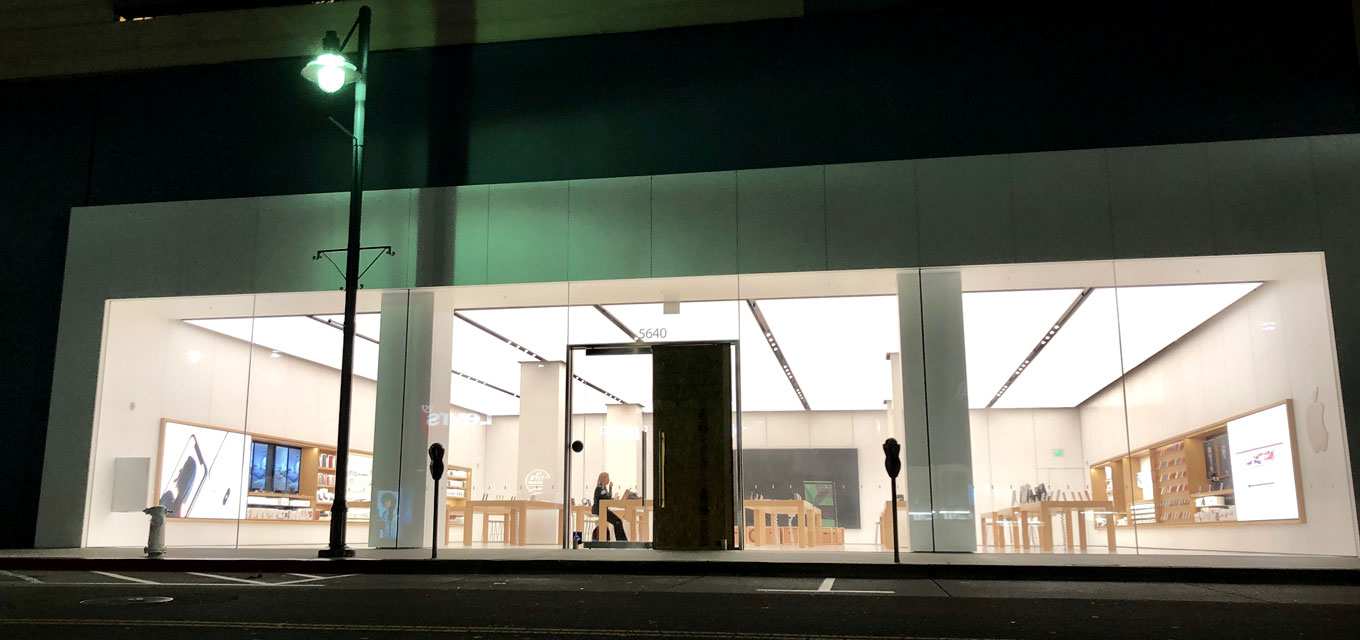
The new flagship Apple Bay Street in Emeryville, Calif. at its current location which opened in 2016, its second relocation since its original grand opening 14 years earlier, photographed on a recent Friday evening after business at the shopping center ended for the day. (Photo: Adam Taylor)
I have not yet been to the new flagship version of the Bay Street store in Emeryville. From what I’ve been told by a friend who’s visited the new store, it sounds like they’ve done to Bay Street what they did at Stoneridge by expanding upon the old format. The store now includes, along with the usual product tables, a larger more open Genius Bar area in the back, and a new meeting area called the Forum with stools in front of a gigantic video wall used for workshop and music sessions. Gone is the familiar bright Apple logo atop the storefront shining over the entrance to greet customers which has now been placed in the interior wall and is clearly visible to passersby on the sidewalk. The new store is now twice as wide as its previous space and features a higher ceiling that extends to the apartment level above creating a more open space all around.
I also have not been to the new flagship store at Union Square in San Francisco but I have heard and read about some of its features. Like an all-glass exterior storefront similar to the flagship store on Fifth Avenue in New York City (except above ground) that allows you to see through the entire two floors of the store, how they brought over the glass staircase from the original flagship store on Stockton Street incorporating it into the new store, and the new Genius Grove that has open spaces with outdoor seating under live trees. Plus how its new features and format will become the standard model for all future Apple Stores moving forward.
As we can see from the stores’ growth, expansion, and evolution over the years, it shows no indication of stopping anytime soon. It’s a radical yet innovative concept that changed the face of retail and Apple, Inc. as well. And as we near the Apple Store’s two-decade mark, Apple’s venture into retail has been one of the most successful innovations it has ever come up with and I have enjoyed being part of the adventure along the way.
Do you have a favorite Apple Store? When was the first time you visited one? Leave a reply below, join the discussion on our Facebook group, or send me an email at macntechdude1701e@gmail.com. We’d love to hear from you!
Apple, Inc., the management team of Bay Street shopping center, and property owners Madison Marquette were all contacted for specific details that were to provide additional background information for this story but requests for such information went unanswered.
keywords: #leoandmac #applestore
short link: https://goo.gl/z4EMgR

